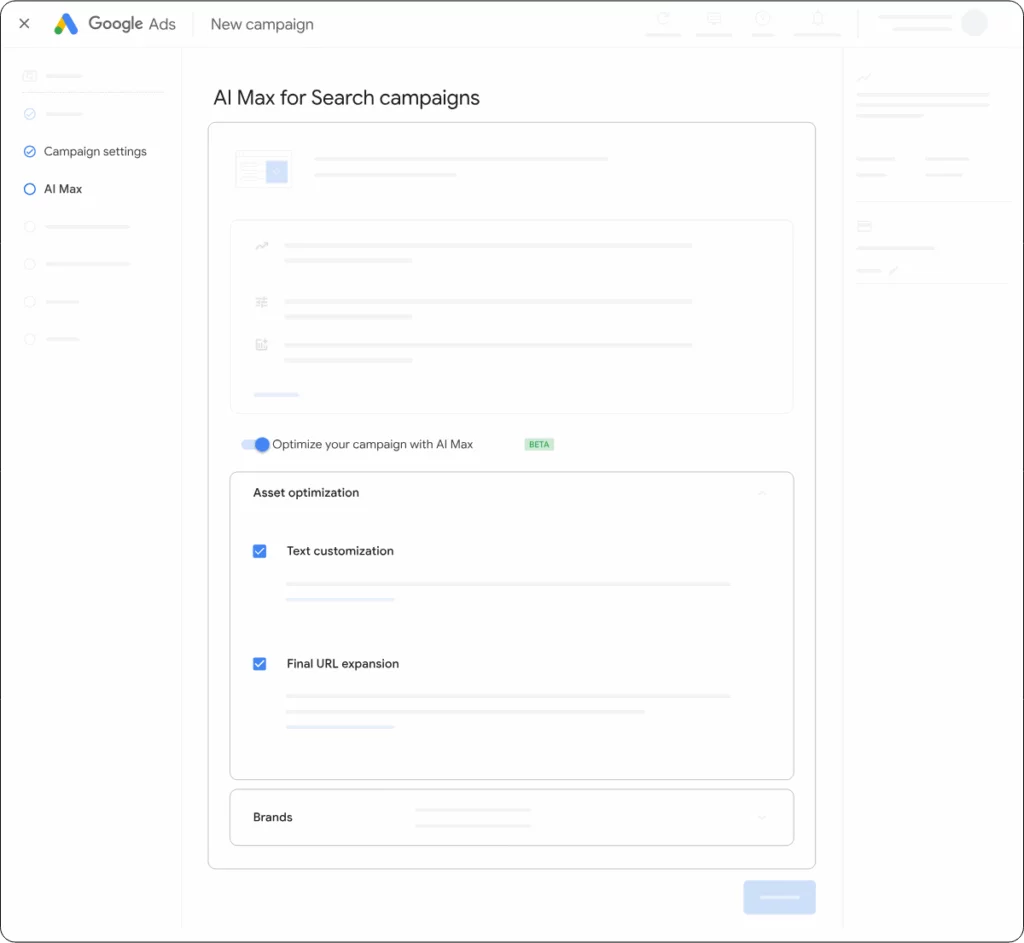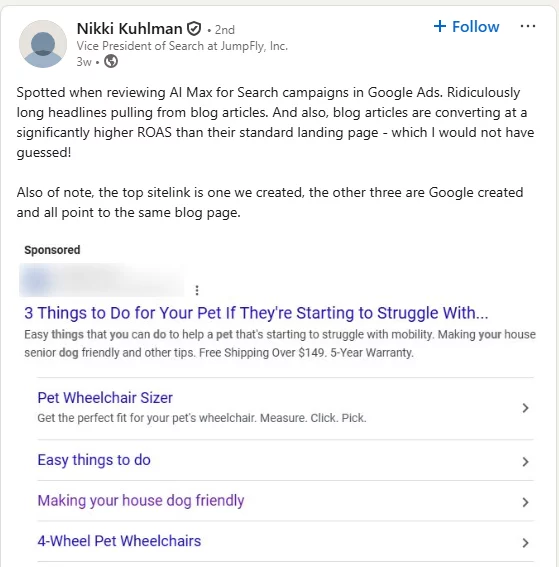- Joined
- Oct 12, 2023
- Messages
- 185
- Reaction score
- 35
Google is rolling out a new type of ad campaigns called Google AI Max. If you run Google Ads, you might feel overwhelmed at times: keywords, bidding, headlines, and endless testing. AI Max promises to take some of that pressure away by letting artificial intelligence do much of the legwork.
But does AI Max come as an actual help for small and medium-sized businesses, or is it just another shiny tool in Google’s shed? Let’s look at how AI Max for Search works, what advertisers are saying, and whether it might make sense for you to try.
AI Max is a campaign type inside Google Ads. It doesn’t ask you to build big lists of keywords like “best pizza in Dallas” or “emergency plumber near me.” Instead, it uses signals like intent, browsing behavior, and demographics to figure out when to show your ad.
According to Google’s official announcement of the AI Max for Search campaigns, the goal is to simplify advertising while still reaching customers ready to buy. For a local florist in Houston or a dog grooming service in Seattle, that should ideally mean less time wrestling with keyword spreadsheets and more time focusing on customers.

Source: Google
Think of it like hiring a data scientist – but exclusively for your search campaigns. AI Max looks at billions of searches, then makes predictions about which ones match your business. Here’s what it handles:
For a full technical dive, Google Ads has a support guide explaining how AI Max works.
If you are already a heavy Google Ads user, here is a lowdown on the main features of AI Max you’ll notice:
This mix can feel like a relief if you’re juggling multiple roles in your business. But giving up control always comes with a trade-off.

Source: Google
Industry reviews show mixed early results. Some businesses reported more clicks at a lower cost. Others found the automation confusing – they weren’t sure why Google chose certain placements. Finally, some flag extremely long headlines (which is unusual for typical Google Ads) and pulling content from blog pages (while many advertisers prefer to land users on commercially focused parts of the website).

Source: LinkedIn
If you scroll through this Reddit thread, you’ll see a mix of enthusiasm and hesitation. Some marketers like the simplicity, others feel uneasy about how much control they’re giving up.
A Q&A for advertisers highlighted one key point: AI Max saves time, but advertisers have less visibility into the “why” behind the numbers. If you’re used to tweaking bids daily, that might feel frustrating – but if you prefer to keep a close control, it might take time to adjust.
AI Max isn’t everywhere yet. Google has said it’s coming to all advertisers in Q3 2025. For now, only a test group can use it. Even if you don’t have access yet, you can prepare. Explore AI tools for digital marketing that already cut down on manual tasks. And remember: automation can be helpful, but balance it with strategy.
It’s also worth keeping an eye on how AI in the domain industry is shaping other parts of the web. Advertising isn’t the only place automation is changing the rules.
AI Max is Google’s biggest step toward fully automated ads. For many small businesses, that could lower the barrier to advertising online. But like any new tool, it comes with trade-offs. If you value control, you may find the system restrictive. If you value simplicity, you may welcome it with open arms. Either way, it’s a sign that the future of search ads is moving toward automation – whether we’re ready or not.
Google AI Max is an AI-driven ad campaign type that removes the need for keyword lists. It uses machine learning to decide who sees your ad and when.
Once it rolls out to all advertisers, you’ll be able to select “AI Max” when creating a new campaign in Google Ads.
It analyzes billions of searches, interprets user intent, adjusts bids automatically, and generates ad variations in real time.
It’s designed for businesses that want simpler campaign setup without hiring an ad specialist.
By lowering bids on low-quality clicks and prioritizing users more likely to convert, it stretches ad budgets further.
It means ads aren’t tied to exact keywords. AI understands the intent behind searches and matches ads accordingly.
Not right away. Traditional keyword campaigns will still exist, but AI Max shows where Google is heading: automation-first advertising.
Continue reading on the it.com Domains blog...
But does AI Max come as an actual help for small and medium-sized businesses, or is it just another shiny tool in Google’s shed? Let’s look at how AI Max for Search works, what advertisers are saying, and whether it might make sense for you to try.
What Google AI Max Actually Is
AI Max is a campaign type inside Google Ads. It doesn’t ask you to build big lists of keywords like “best pizza in Dallas” or “emergency plumber near me.” Instead, it uses signals like intent, browsing behavior, and demographics to figure out when to show your ad.
According to Google’s official announcement of the AI Max for Search campaigns, the goal is to simplify advertising while still reaching customers ready to buy. For a local florist in Houston or a dog grooming service in Seattle, that should ideally mean less time wrestling with keyword spreadsheets and more time focusing on customers.

Source: Google
How AI Max Works
Think of it like hiring a data scientist – but exclusively for your search campaigns. AI Max looks at billions of searches, then makes predictions about which ones match your business. Here’s what it handles:
- Targeting without keywords. Instead of showing ads only when someone searches for “Seattle grooming services,” AI Max guesses the user intent and shows ads when the timing feels right – even if you don’t have a specific keyword in your target list.
- Budget protection. In traditional search ads, you might accidentally pay for clicks that don’t lead to sales – for example, someone searching “free dog grooming tips” clicking your ad for a paid grooming service. That’s budget leakage. AI Max constantly adjusts how much you bid and where your ads show – for example. The system lowers bids or skips auctions where a user looks unlikely to convert.
- Creative testing. The system writes and rotates ad headlines until it finds what works best and resonates with search users.
- Final URL extension. AI algorithm picks the most relevant pages from your domain to send the users to the right places of your website – and also prompts you to optimize your landing pages in real time.
- Multi-channel reach. AI Max ads appear across Search, Maps, YouTube, and Shopping.
For a full technical dive, Google Ads has a support guide explaining how AI Max works.
If you are already a heavy Google Ads user, here is a lowdown on the main features of AI Max you’ll notice:
- No keyword lists to manage.
- Ads that adapt automatically.
- Bid adjustments happening every second.
- Less manual control, more automation.
This mix can feel like a relief if you’re juggling multiple roles in your business. But giving up control always comes with a trade-off.

Source: Google
Early Results: a Mixed Picture
Industry reviews show mixed early results. Some businesses reported more clicks at a lower cost. Others found the automation confusing – they weren’t sure why Google chose certain placements. Finally, some flag extremely long headlines (which is unusual for typical Google Ads) and pulling content from blog pages (while many advertisers prefer to land users on commercially focused parts of the website).

Source: LinkedIn
If you scroll through this Reddit thread, you’ll see a mix of enthusiasm and hesitation. Some marketers like the simplicity, others feel uneasy about how much control they’re giving up.
A Q&A for advertisers highlighted one key point: AI Max saves time, but advertisers have less visibility into the “why” behind the numbers. If you’re used to tweaking bids daily, that might feel frustrating – but if you prefer to keep a close control, it might take time to adjust.
AI Max vs Traditional Search Ads
| Feature | Traditional ads | Google AI Max |
| Targeting | Keywords you choose | Intent-driven, no keywords |
| Creative | You write headlines | AI generates & rotates |
| Control | High but time-consuming | Low but efficient |
| Budget | Manual bidding | Automated adjustments |
| Best fit | Experienced ad managers | Small businesses needing speed |
What Small Businesses Can Do Right Now
AI Max isn’t everywhere yet. Google has said it’s coming to all advertisers in Q3 2025. For now, only a test group can use it. Even if you don’t have access yet, you can prepare. Explore AI tools for digital marketing that already cut down on manual tasks. And remember: automation can be helpful, but balance it with strategy.
It’s also worth keeping an eye on how AI in the domain industry is shaping other parts of the web. Advertising isn’t the only place automation is changing the rules.
Key Takeaways
- Google AI Max automates ad targeting, creative, and bidding.
- Early results are promising but uneven.
- The rollout begins in late 2025.
- It could help small businesses run ads with less manual setup.
- Transparency is still limited, so human oversight will matter.
AI Max is Google’s biggest step toward fully automated ads. For many small businesses, that could lower the barrier to advertising online. But like any new tool, it comes with trade-offs. If you value control, you may find the system restrictive. If you value simplicity, you may welcome it with open arms. Either way, it’s a sign that the future of search ads is moving toward automation – whether we’re ready or not.
FAQs
What is Google AI Max?
Google AI Max is an AI-driven ad campaign type that removes the need for keyword lists. It uses machine learning to decide who sees your ad and when.
How to enable AI Max?
Once it rolls out to all advertisers, you’ll be able to select “AI Max” when creating a new campaign in Google Ads.
How does Google AI Max work?
It analyzes billions of searches, interprets user intent, adjusts bids automatically, and generates ad variations in real time.
Who should use AI Max?
It’s designed for businesses that want simpler campaign setup without hiring an ad specialist.
How does AI Max prevent wasted spend?
By lowering bids on low-quality clicks and prioritizing users more likely to convert, it stretches ad budgets further.
What is keywordless technology?
It means ads aren’t tied to exact keywords. AI understands the intent behind searches and matches ads accordingly.
Will AI Max replace keyword targeting?
Not right away. Traditional keyword campaigns will still exist, but AI Max shows where Google is heading: automation-first advertising.
Continue reading on the it.com Domains blog...



